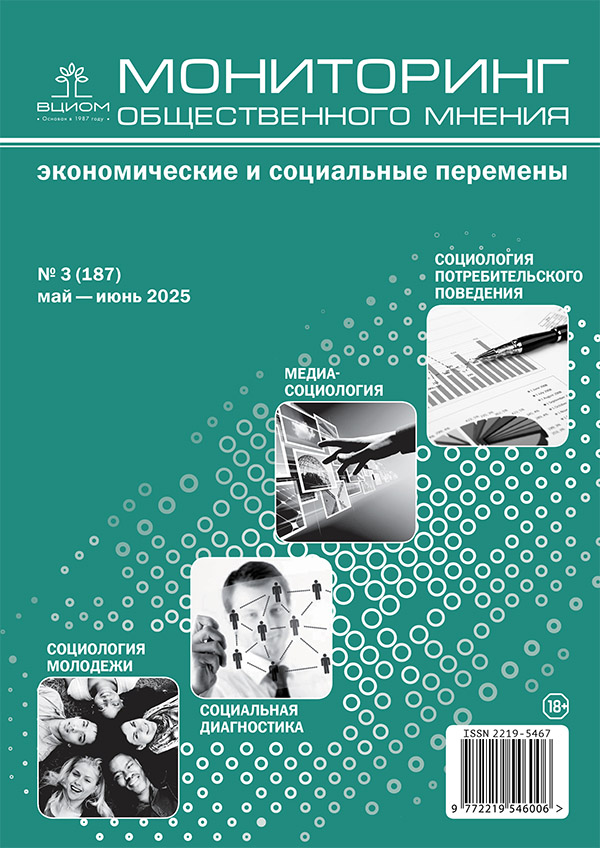Обыденное приписывание агентности и ответственности военным беспилотным летательным аппаратам: виньеточный эксперимент на российской выборке
DOI:
https://doi.org/10.14515/monitoring.2025.3.2725Ключевые слова:
обыденное знание, исследования науки и техники, взаимодействие человека и ИИ, факторный эксперимент, беспилотные летательные аппараты (БПЛА), исследования военных конфликтов, акторно-сетевая теорияАннотация
В статье представлены результаты факторного виньеточного эксперимента, исследующего атрибуцию ответственности и агентности в военных контекстах. Особое внимание уделено взаимодействию между двумя суверенными государствами, типу военной ситуации и степени автономности вовлеченных акторов. Выборка исследования составляет 1103 участника, прошедших онлайн-опрос. Участники исследования склонны приписывать более высокий уровень агентности акторам, участвующим в невоенных операциях, чем в военных. Люди, выступающие в роли акторов, получили самые высокие оценки как с точки зрения ответственности, так и с точки зрения агентности. Беспилотным летательным аппаратам (БПЛА), оснащенным искусственным интеллектом, приписывается больше агентности и ответственности, чем беспилотникам на дистанционном управлении. Участники исследования склонны приписывать более высокий уровень ответственности стороне конфликта, представляющей их собственную страну. Мы обнаружили, что доверие, позитивное отношение к БПЛА и тенденция к антропоморфизации БПЛА положительно коррелируют с атрибуцией агентности и ответственности. Эти результаты дают общее представление о меняющемся восприятии современных военных конфликтов, где все более заметной становится интеграция в военных действиях как людей-комбатантов, так и передовых технологий, среди которых автономные системы, управляемые искусственным интеллектом.
Библиографические ссылки
Ashrafian H. (2015) Artificial Intelligence and Robot Responsibilities: Innovating Beyond Rights. Science and Engineering Ethics. No. 21. P. 317—326. https://doi.org/10.1007/s11948-014-9541-0.
Atzmüller C., Steiner, P.M. (2010) Experimental Vignette Studies in Survey Research. Methodology. Vol. 6. No. 3. P. 128—138. https://doi.org/10.1027/1614-2241/a000014.
Awad E., Dsouza S., Kim R., Schulz J., Henrich J., Shariff A., Bonnefon J., Rahwan I. (2018) The Moral Machine Experiment. Nature. Vol. 563. No. 7729. P. 59—64. https://doi.org/10.1145/3339904.
Azafrani R., Gupta A. (2023) Bridging the Civilian-Military Divide in Responsible AI Principles and Practices. Ethics and Information Technology. Vol. 25. No. 2. https://doi.org/10.1007/s10676-023-09693-y.
Berinsky A. J., Margolis M. F., Sances M. W. (2014). Separating the Shirkers from the Workers? Making Sure Respondents Pay Attention on Self‐Administered Surveys. American Journal of Political Science. Vol. 58. No. 3. P. 739—753. https://doi.org/10.1111/ajps.12081.
Boddery S.S., Klein G.R. (2021) Presidential Use of Diversionary Drone Force and Public Support. Research & Politics. Vol. 8. No. 2. Art. 20531680211019904. http://dx.doi.org/10.1177/20531680211019904.
Buchanan E. M., Scofield J. E. (2018) Methods to Detect Low Quality Data and Its Implication for Psychological Research. Behavior Research Methods. Vol. 50. P. 2586—2596. https://doi.org/10.3758/s13428-018-1035-6
Caspar E.A., Lo Bue S., Magalhães De Saldanha da Gama P.A., Haggard P., Cleeremans A. (2020) The Effect of Military Training on the Sense of Agency and Outcome Processing. Nature Communications. Vol. 11. No. 1. P. 1—10. https://doi.org/10.1038/s41467-020-18152-x.
Chamayou G. (2015) A Theory of the Drone. New York: The New Press.
Cleaver F. (2004) The Social Embeddedness of Agency and Decision-Making. In: Hickey S., Mohan G. Participation: From Tyranny to Transformation: Exploring New Approaches to Participation in Development. New York, NY: Zed books. P. 271—277.
Coeckelbergh M. (2009) Virtual Moral Agency, Virtual Moral Responsibility: On the Moral Significance of the Appearance, Perception, and Performance of Artificial Agents. AI & SOCIETY. Vol. 24. No. 2. P. 181—189. https://doi.org/10.1007/s00146-009-0208-3.
De Sio Filippo S., Di Nucci E. (2016) Drones and Responsibility: Mapping the Field. In: De Sio Filippo S., Di Nucci E. Drones and Responsibility: Legal, Philosophical and Socio-Technical Perspectives on Remotely Controlled Weapons. Abingdon: Routledge. P. 1—13.
DeLanda M. (1991) War in the Age of Intelligent Machines. New York: Zone Books.
DeLanda M. (2019) A New Philosophy of Society: Assemblage Theory and Social Complexity. London: Bloomsbury Publishing.
Deviatko I.F., Gavrilov K.A. (2020) Causality and Blame Judgments of Negative Side Effects of Actions May Differ for Different Institutional Domains. SAGE Open. Vol. 10. No. 4. https://doi.org/10.1177/2158244020970942.
Diakopoulos N. (2020). Accountability, Transparency. The Oxford handbook of ethics of AI. Vol. 17. No. 4. P. 197—214.
Elish M.C. (2017) Remote Split: A History of US Drone Operations and the Distributed Labor of War. Science, Technology, & Human Values. Vol. 42. No. 6. P. 1100—1131. https://doi.org/10.1177/0162243917731523.
Faul F., Erdfelder E., Lang A.G., Buchner A. (2007) G*Power 3: A Flexible Statistical Power Analysis Program for the Social, Behavioral, and Biomedical Sciences. Behavior Research Methods. Vol. 39. No. 2. P. 175—191. https://doi.org/10.3758/bf03193146.
Floridi L., Sanders J. W. (2004). On the Morality of Artificial Agents. Minds and Machines. Vol. 14. No. 3. P. 349—379. https://doi.org/10.1023/b:mind.0000035461.63578.9d.
Fritsche I. (2022) Agency Through the We: Group-Based Control Theory. Current Directions in Psychological Science. Vol. 31. No. 2. P. 194—201. https://doi.org/10.1177/09637214211068838.
Girard R. (2010) Battling to the End: Conversations with Benoît Chantre. Michigan: MSU Press.
Gulevich O.A., Osin E.N. (2023) Generalized Trust and Military Attitudes in Russia: The Role of National and Global Human Identification. The British Journal of Social Psychology. Vol. 62. No. 3. P. 1566—1579. https://doi.org/10.1111/bjso.12648.
Haladjian H.H., Montemayor C. (2016) Artificial Consciousness and the Consciousness-Attention Dissociation. Consciousness and Cognition. Vol. 45. P. 210—225. https://doi.org/10.1016/j.concog.2016.08.011.
Hameleers M., Bos L., De Vreese C.H. (2016) ‘They Did It’: The Effects of Emotionalized Blame Attribution in Populist Communication. Communication Research. Vol. 44. No. 6. P. 1—31. https://doi.org/10.1177/0093650216644026.
Hellström T. (2013) On the Moral Responsibility of Military Robots. Ethics and Information Technology. Vol. 15. No. 2. P. 99—107. https://doi.org/10.1007/s10676-012-9301-2.
Huntington S. P. (1981) The Soldier and the State: The Theory and Politics of Civil—Military Relations. Cambridge, MA: Harvard University Press.
Jensen T., Albayram Y., Maifi K.M., Buck R., Coman E., Fahim M.A. (2018) Initial Trustworthiness Perceptions of a Drone System Based on Performance and Process Information. In: Proceedings of the 6th International Conference on Human-Agent Interaction. P. 229—237. https://doi.org/10.1145/3284432.3284435.
Kaspe S.I. (2021) Life, Death, and the State. Russia in Global Affairs. Vol. 19. No. 3. P. 174—204. https://doi.org/10.31278/1810-6374-2021-19-3-174-204.
Kazim E., Koshiyama A.S. (2021) A High-Level Overview of AI Ethics. Patterns. Vol. 2. No. 9. Art. 100314. https://doi.org/10.1016/j.patter.2021.100314.
Korbut A.M. (2019) User Response to Failures in Interaction with Computers: A Sociological Analysis. Journal of Sociology and Social Anthropology. Vol. 22. No. 6. P. 27—43. https://doi.org/10.31119/jssa.2019.22.6.3. (In Russ.)
Корбут А. М. Реакция пользователей на сбои во взаимодействии с компьютерами: социологический анализ // Журнал социологии и социальной антропологии. 2019. Т. 22. № 6. С. 27—43.
Kreps S.E. (2014) Flying Under the Radar: A Study of Public Attitudes Towards Unmanned Aerial Vehicles. Research & Politics. Vol. 1. No. 1. https://doi.org/10.1177/2053168014536533.
Kreps S.E., Wallace G.P.R. (2016) International Law, Military Effectiveness, and Public Support for Drone Strikes. Journal of Peace Research. Vol. 53. No. 6. P. 830—844. https://doi.org/10.1177/0022343316657405.
Kuznetsov A.G. (2020) Neural Network Nebulae: ‘Black Boxes’ of Technologies and Object-Lessons from the Opacities of Algorithms. Sociology of Power. Vol. 32. No. 2. P. 157—182.
https://doi.org/10.22394/2074-0492-2020-2-157-182. (In Russ.)
Кузнецов А. Г. Туманности нейросетей: «Черные ящики» технологий и наглядные уроки непрозрачности алгоритмов // Социология власти. 2020. Т. 32. № 2. С. 157—182.
Latour B. (2007) Reassembling the Social: An Introduction to Actor-Network-Theory. OUP Oxford.
Law J. (2002) Objects and Spaces. Theory, Culture & Society. Vol. 19. No. 5-6. P. 91—105.
https://doi.org/10.1177/026327602761899165.
Leach C.W., Van Zomeren M., Zebel S., Vliek M.L., Pennekamp S.F., Doosje B., Ouwerkerk J.W., Spears R. (2008) Group-Level Self-Definition and Self-Investment: A Hierarchical (Multicomponent) Model of In-Group Identification. Journal of Personality and Social Psychology. Vol. 95. No.1. P. 144—165. https://doi.org/10.1037/0022-3514.95.1.144.
Lee J.D., Kolodge K. (2018) Understanding Attitudes Towards Self-Driving Vehicles: Quantitative Analysis of Qualitative data. Proceedings of the Human Factors and Ergonomics Society Annual Meeting. Vol. 62. No. 1. P. 1399—1403. https://doi.org/10.1177/1541931218621319.
Li X., Hess T.J., Valacich J.S. (2008) Why Do We Trust New Technology? A Study of Initial Trust Formation with Organizational Information Systems. Journal of Strategic Information Systems. Vol. 17. No. 1. P. 39—71. https://doi.org/10.1016/j.jsis.2008.01.001.
Liu P., Du Y. (2022) Blame Attribution Asymmetry in Human—Automation Cooperation. Risk Analysis. Vol. 42. No. 8. P. 1769—1783. https://doi.org/10.1111/risa.13674.
Marchant G.E., Allenby B., Arkin R., Barrett E.T., Borenstein J., Gaudet L.M., Kittrie O., Lin P., Lucas G.R., O’Meara R., Silberman J. (2011) International Governance of Autonomous Military Robots. Columbia Science and Technology Law Review. Vol. 12. P. 272—315.
https://doi.org/10.1007/978-90-481-9707-1_102.
Matthias A. (2004) The Responsibility Gap: Ascribing Responsibility for the Actions of Learning Automata.Ethics and Information Technology. Vol. 6. No. 3. P. 175—183. https://doi.org/10.1007/s10676-004-3422-1.
Ng G.W., Leung W.C. (2020) Strong Artificial Intelligence and Consciousness. Journal of Artificial Intelligence and Consciousness. Vol. 7. No. 1. P. 63—72. https://doi.org/10.1142/s2705078520300042.
Peng Y. (2020) The Ideological Divide in Public Perceptions of Self-Driving Cars. Public Understanding of Science. Vol. 29. No. 4. P. 436—451. https://doi.org/10.1177/0963662520917339.
Rosendorf O., Smetana M., Vranka M. (2022) Autonomous Weapons and Ethical Judgments: Experimental Evidence on Attitudes Toward the Military Use of ‘Killer Robots’. Peace and Conflict: Journal of Peace Psychology. Vol. 28. No. 2. P. 177—183.
https://doi.org/10.1037/pac0000601.
Santoni De Sio F., Mecacci G. (2021) Four Responsibility Gaps with Artificial Intelligence: Why they Matter and How to Address Them. Philosophy & Technology. Vol. 34. No. 4. P. 1057—1084. https://doi.org/10.1007/s13347-021-00450-x.
Smirnov N.M. (2021) Who Is to Blame and What Is to Be Done: Analysis of Comments to Films about the Beslan School Siege. Social Psychology and Society. Vol. 12. No. 3. P. 74—86. https://doi.org/10.17759/sps.2021120306. (In Russ.)
Смирнов Н. М. Кто виноват и что делать: анализ комментариев к фильмам о бесланском теракте // Социальная психология и общество. 2021. Т. 12. № 3. С. 74—86. https://doi.org/10.17759/sps.2021120306.
Stilgoe J. (2020) Who’s Driving Innovation? New Technologies and the Collaborative State. Cham: Palgrave Macmillan.
Takayama L. (2015) Telepresence and Apparent Agency in Human—Robot Interaction. In: Sundar S.Sh. (ed.) The Handbook of the Psychology of Communication Technology. Chichester: John Wiley & Sons. P. 160—175. https://doi.org/10.1002/9781118426456.ch7.
Torrance S. (2008) Ethics and Consciousness in Artificial Agents. AI & SOCIETY. Vol. 22. No. 4. P. 495—521. https://doi.org/10.1007/s00146-007-0091-8.
Von Clausewitz C. (1976) On War. Princeton: Princeton University Press.
Wagner W., Viidalepp A., Idoiaga-Mondragon N., Talves K., Lillemäe E., Pekarev J., Otsus M. (2023) Lay Representations of Artificial Intelligence and Autonomous Military Machines. Public Understanding of Science. Vol. 32. No. 7. P. 926-943.
https://doi.org/10.1177/09636625231167071.
Walsh J.I. (2015) Precision Weapons, Civilian Casualties, and Support for the Use of Force. Political Psychology. Vol. 36. No. 5. P. 507—523. https://doi.org/10.1111/pops.12175.
Waytz A., Cacioppo J., Epley N. (2010) Who Sees Human? The Stability and Importance of Individual Differences in Anthropomorphism. Perspectives on Psychological Science. Vol. 5. No. 3. P. 219—232. https://doi.org/10.1177/1745691610369336.
Zmud J., Sener I.N., Wagner J. (2016) Consumer Acceptance and Travel Behavior: Impacts of Automated Vehicles (No. PRC 15-49 F). Texas A&M Transportation Institute. https://rosap.ntl.bts.gov/view/dot/32687.
Загрузки
Опубликован
Как цитировать
Выпуск
Раздел
Лицензия
Copyright (c) 2025 Мониторинг общественного мнения: экономические и социальные перемены

Это произведение доступно по лицензии Creative Commons «Attribution-NonCommercial-ShareAlike» («Атрибуция — Некоммерческое использование — На тех же условиях») 4.0 Всемирная.






